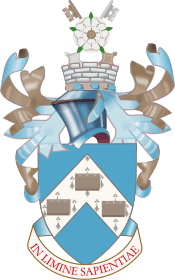Hull York Medical School
 | |
| Type | Medical school |
|---|---|
| Established | 2003 |
| Dean | Professor Trevor Sheldon |
| Location |
Kingston upon Hull |
| Qualification gained | MBBS with optional intercalated BSc |
| Affiliations |
University of Hull University of York National Health Service |
| Website | http://www.hyms.ac.uk |
The Hull York Medical School (HYMS) is a medical school in England which took its first intake of students in 2003. The school was opened as a part of the British Government's attempts (under the Labour Party) to train more doctors, which also saw Brighton and Sussex Medical School, Peninsula Medical School and University of East Anglia Medical School open their doors.
History
The early history of medical education in Hull and York goes back to the three following institutions: Hull Medical School (1831), York Medical Society(1832) and the York Medical School (1834).[1] Notable doctors associated with the York school included John Hughlings Jackson (in whose honour the modern medical school building at the University of York is named), Daniel Hack Tuke, Thomas Laycock (physiologist), James Atkinson (surgeon), and Sir Jonathan Hutchinson. It is thought that the York school closed in the 1860s.
The founding of a medical school as part of the University of Hull was considered in the Report of the Royal Commission on Medical Education 1965–68 (Todd Report) (published 1968), but the idea was thought not to be viable until the Humber Bridge was completed, as this would enable students to travel to placements in South Lincolnshire.
Teaching
The medical school admits 140 students each year. Around 1,000 applied for 2013 entry.[2] Of the successful applicants each year, half are based at the University of Hull and the other half are based at the University of York for the first two years of their course. In 2014, HYMS was ranked 20th in the UK by the Guardian University Subject Guide and 27th in the UK by the Complete University Guide 2014. As of 2006 applicants have been required to sit the UKCAT admissions test. Information about the test and preparation can be found at UKCAT.
The course has had, in the past, a high proportion of mature students when compared to other medical courses. The 2005 intake had 44 mature students spread over both Hull and York universities, a higher number than in most medical schools.
Students spend the two years in phase one at their academic bases (either Hull or York). Phase two consists of rotation around York, Hull, Scunthorpe, Grimsby and Scarborough. In the final year of the course (phase three), students essentially take on the role of a 'junior' pre-registration house officer and are also able to carry out an 'elective' period overseas. This is a common feature in most UK medical curricula. The school's first international students began their studies in September 2006.

The HYMS course uses problem-based learning[3] as opposed to more traditional teaching methods, and students see a great deal of clinical contact from the first year of their course as opposed to other medical schools. This has been praised by the General Medical Council and students alike, who see the vocational nature of the course one of the most exciting parts of their medical education. There is also a great emphasis on the community aspects of medicine, with students spending half of their time in General Practice as opposed to the more traditional hospital oriented clinical placements.
The course uses clinically orientated subjects, as opposed to traditional medical school subjects which are more abstract science based. Like other medical schools, HYMS also offers the ability to intercalate a BSc degree in various subjects, such as anatomy, biology and ethics.
Students spend five years at HYMS and graduate with an MB BS degree (Bachelor of Medicine, Bachelor of Surgery).
List of Deans
- Professor William Gillespie OBE (2003–2007)
- Professor Ian Greer (2007–2010)
- Professor Tony Kendrick (2010–2013)
- Professor Trevor Sheldon (Dean from November 2013)
Staff
Professor John Lee, professor of Clinical Pathology was a co-presenter on Anatomy for Beginners (screened in the UK on Channel 4 in 2005) in which he explained the dissections of Gunther von Hagens. He co-presented a second series with von Hagens in 2006 called Autopsy: Life and Death (Channel 4, 2006).
Notes
- ↑ WETHERILL JH (July 1961). "The York Medical School". Med Hist. 5: 253–69. doi:10.1017/s0025727300026399. PMC 1034628
 . PMID 13784646.
. PMID 13784646. - ↑ "www.hyms.ac.uk HYMS applications webpage". hyms.ac.uk. Retrieved 26 February 2013.
- ↑ HYMS Problem Based Learning guide
